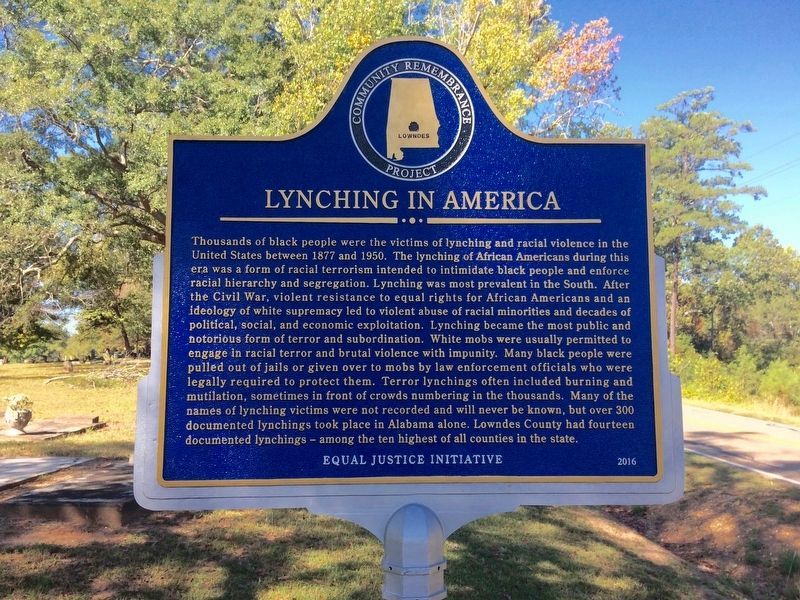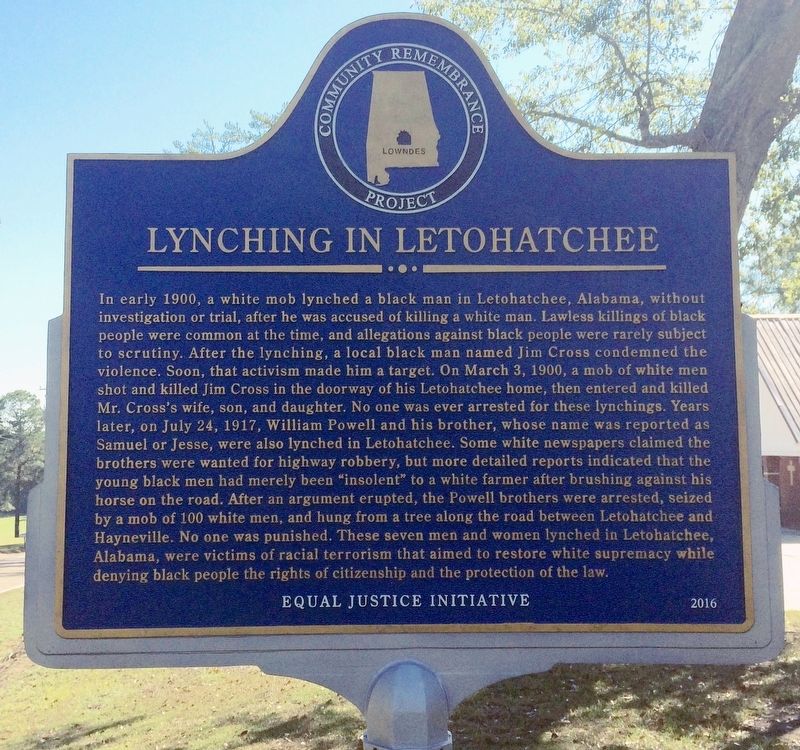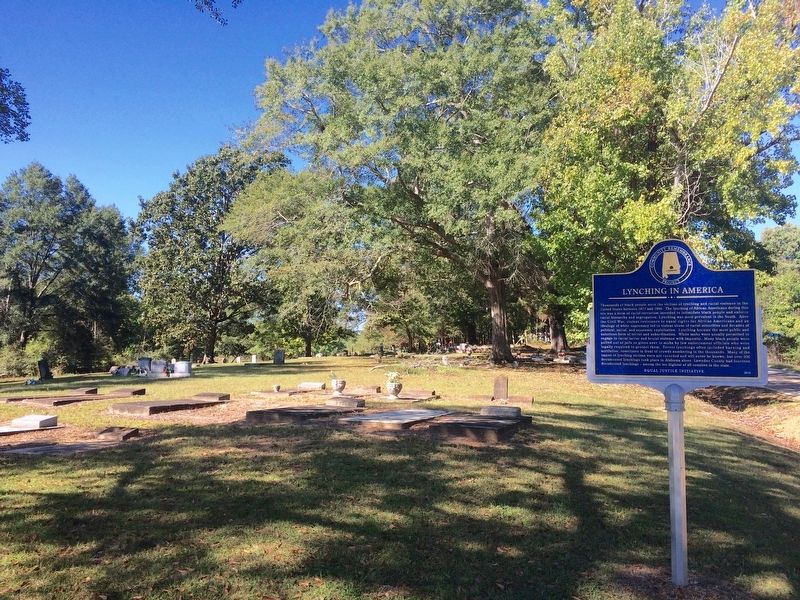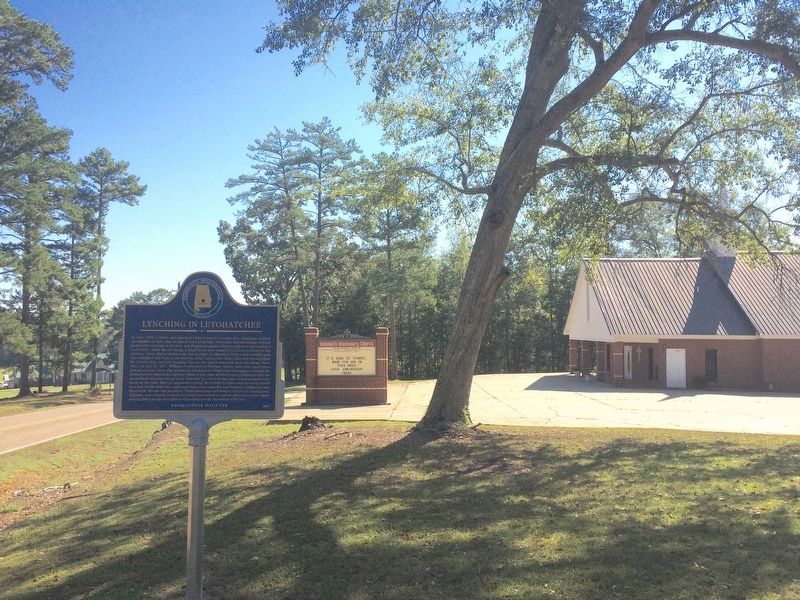Mt. Carmel in Lowndes County, Alabama — The American South (East South Central)
Lynching in America / Lynching in Letohatchee
Community Remembrance Project
Thousands of black people were the victims of lynching and racial violence in the United States between 1877 and 1950. The lynching of African Americans during this era was a form of racial terrorism intended to intimidate black people and enforce racial hierarchy and segregation. Lynching was most prevalent in the South. After the Civil War, violent resistance to equal rights for African Americans and an ideology of white supremacy led to violent abuse of racial minorities and decades of political, social, and economic exploitation. Lynching became the most public and notorious form of terror and subordination. White mobs were usually permitted to engage in racial terror and brutal violence with impunity. Many black people were pulled out of jails or given over to mobs by law enforcement officials who were legally required to protect them. Terror lynchings often included burning and mutilation, sometimes in front of crowds numbering in the thousands. Many of the names of lynching victims were not recorded and will never be known, but over 300 documented lynchings took place in Alabama alone. Lowndes County had fourteen documented lynchings – among the ten highest of all counties in the state.
In early 1900, a white mob lynched a black man in Letohatchee, Alabama, without investigation or trial, after he was accused of killing a white man. Lawless killings of black people were common at the time, and allegations against black people were rarely subject to scrutiny.
After the lynching, a local black man named Jim Cross condemned the violence. Soon, that activism made him a target. On March 3, 1900, a mob of white men shot and killed Jim Cross in the doorway of his Letohatchee home, then entered and killed Mr. Cross’s wife, son, and daughter. No one was ever arrested for these lynchings.
Years later, on July 24, 1917, William Powell and his brother, whose first name was reported as Samuel or Jesse, were also lynched in Letohatchee. Some white newspapers claimed the brothers were wanted for highway robbery, but more detailed reports indicated that the young black men had merely been "insolent" to a white farmer after brushing against his horse on the road. After an argument erupted, the Powell brothers were arrested, seized by a mob of 100 white men, and hung from a tree along the road between Letohatchee and Hayneville. No one was punished.
These seven people lynched in Letohatchee, Alabama, were victims of racial terrorism that aimed to restore white supremacy while denying black people the rights of citizenship and the protection of the law.
Erected 2016 by Equal Justice Initiative, Community Remembrance Project.
Topics and series. This historical marker is listed in these topic lists: African Americans • Churches & Religion • Notable Events. In addition, it is included in the Lynching in America series list. A significant historical date for this entry is March 3, 1900.
Location. 32° 3.914′ N, 86° 23.058′ W. Marker is in Mt. Carmel, Alabama, in Lowndes County. Marker is on West Hickory Grove Road, 1.3 miles east of Route 97, on the right when traveling east. While the marker is in the Letohatchee zip code area, this community and church are in nearby Montgomery County. Touch for map. Marker is at or near this postal address: 5267 W Hickory Grove Rd, Letohatchee AL 36047, United States of America. Touch for directions.
Other nearby markers. At least 8 other markers are within 9 miles of this marker, measured as the crow flies. Tankersley Rosenwald School (approx. 5.6 miles away); Fair Prospect Cemetery Montgomery County (approx. 6.7 miles away); The Federal Road / Manac's Tavern (approx. 7.7 miles away); Federal Road, 1805, (approx. 7.7 miles away); Pintlala School (approx. 7.7 miles away); Pintlala Grange Hall / Grange Hall School (approx. 7.7 miles away); The Bethel Cemetery (approx. 8.4 miles away); Site of Highland Home College (approx. 8.8 miles away).
Related marker. Click here for another marker that is related to this marker. Marker about another lynching in Alabama.
Also see . . . Equal Justice Initiative website story about dedication of marker. (Submitted on September 20, 2016, by Mark Hilton of Montgomery, Alabama.)
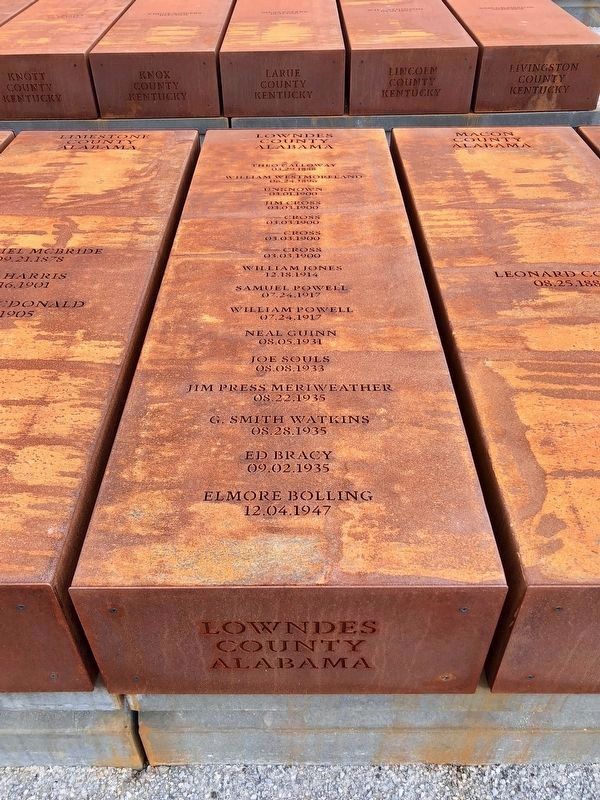
Photographed By Mark Hilton, May 31, 2018
5. People lynched in Lowndes County including those on the marker above.
Part of the National Memorial for Peace and Justice, in Montgomery, Alabama, the memorial is dedicated to the legacy of enslaved black people, people terrorized by lynching, African Americans humiliated by racial segregation and Jim Crow, and people of color burdened with contemporary presumptions of guilt and police violence.
One of the over 800 corten steel monuments, one for each county in the United States where a racial terror lynching took place.
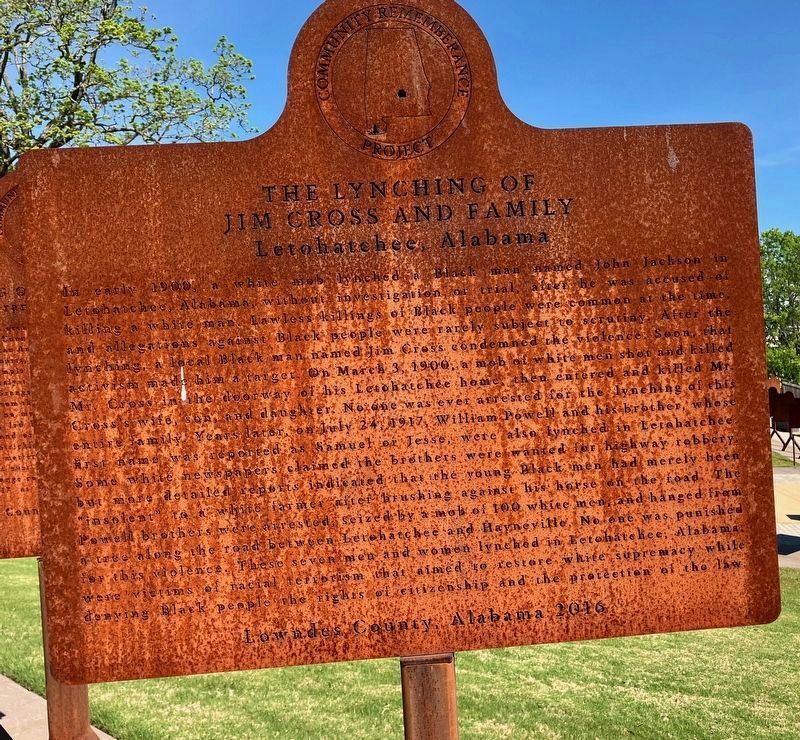
Photographed By Mark Hilton, April 6, 2024
6. Lynching in Letohatchee Marker
A Replica marker of one side (with minor textual changes) is located at the Equal Justice Initiatives' National Memorial for Peace and Justice in Montgomery, Alabama. The Equal Justice Initiative supports efforts to locally memorialize documented victims of racial violence and to educate communities about the history of racial injustice.
Credits. This page was last revised on April 6, 2024. It was originally submitted on September 20, 2016, by Mark Hilton of Montgomery, Alabama. This page has been viewed 1,033 times since then and 95 times this year. Photos: 1, 2, 3, 4. submitted on September 20, 2016, by Mark Hilton of Montgomery, Alabama. 5. submitted on May 31, 2018, by Mark Hilton of Montgomery, Alabama. 6. submitted on April 6, 2024, by Mark Hilton of Montgomery, Alabama.
